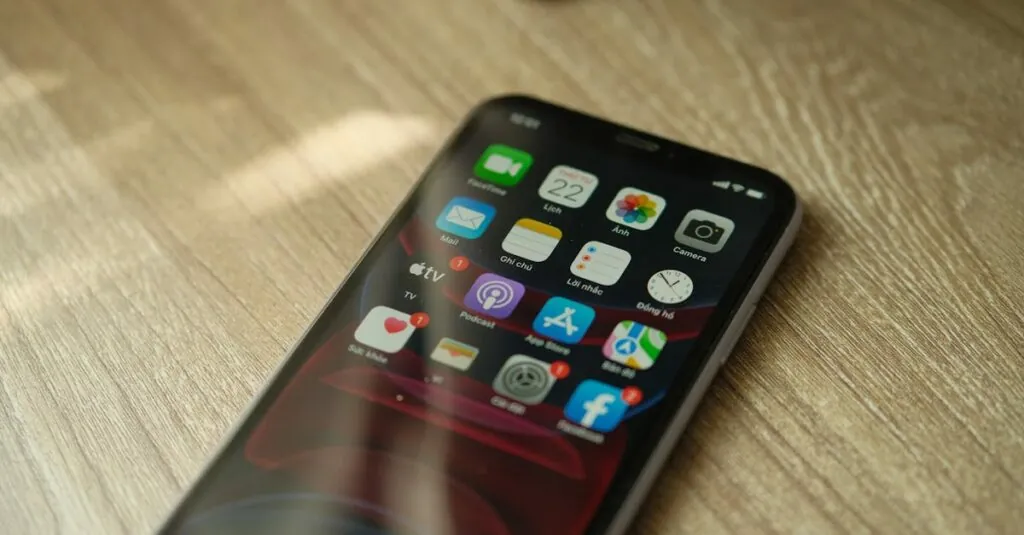Table of Contents
TogglePush notifications on an iPhone are like little digital cheerleaders, always ready to keep users in the loop. But what happens when these enthusiastic alerts go missing? Panic might set in as they wonder if their phone’s gone rogue. Fear not! Finding those push notifications is easier than locating a sock in a laundry basket.
Understanding Push Notifications
Push notifications on an iPhone serve as essential updates that keep users connected to their favorite apps. These alerts provide real-time information about messages, events, and important reminders.
What Are Push Notifications?
Push notifications are messages sent from apps directly to the user’s device. They appear on the home screen or lock screen, acting as alerts for new content or updates. These messages can include promotional offers, social media alerts, and breaking news. Users can customize settings to control which apps send notifications and how they appear.
Importance of Push Notifications
Push notifications enhance user engagement by providing timely information. They keep individuals updated about app activities, thereby increasing interactivity. Businesses utilize these alerts to improve customer retention by sending reminders or encouraging app usage. Notifications also drive immediate responses, leading to higher conversion rates for promotions and events.
Locating Push Notifications on iPhone
Finding push notifications on an iPhone involves checking several settings and features. Users can easily access these alerts through their device’s notification settings and the Notification Center.
Default Notification Settings
Notification settings control how alerts appear. Users should navigate to Settings, then tap Notifications to manage preferences. Here, they can choose which apps send notifications and how those notifications display. Options include sound, alerts, and badges. Users can also toggle Allow Notifications on or off for individual apps. Ensuring correct settings for important apps guarantees that users receive timely updates and reminders.
Accessing Notifications Center
Accessing the Notification Center is straightforward. Swiping down from the top center of the screen reveals recent alerts. This area displays notifications from various apps in chronological order. Clear notifications or manage them directly in the Notification Center, providing an overview of important messages. Users can also swipe left on individual notifications to manage or clear them. This feature ensures users stay updated with minimal disruption.
Managing Push Notifications
Managing push notifications on an iPhone allows users to tailor their alert experience. Customizing these notifications enhances engagement while ensuring important updates are prioritized.
Customizing App Notifications
Users can adjust app notification settings for a more personalized experience. To customize notifications, they should navigate to Settings, then select Notifications. In this menu, options such as allowing alerts, sounds, and badge app icons can be configured. Users might choose to enable or disable previews and adjust how notifications appear on the lock screen. Each app can have unique settings, ensuring that only the most relevant alerts reach the user.
Turning Off Push Notifications
Turning off push notifications can help reduce distractions. Users who prefer a quieter experience can disable notifications by going to Settings, then Notifications. Selecting the app for which notifications should be turned off allows for immediate adjustment. Users can toggle off the “Allow Notifications” option, effectively silencing alerts. This process can be repeated for other apps, providing complete control over app notifications.
Troubleshooting Push Notifications
Push notifications may sometimes stop appearing, leading to user frustration. Identifying and resolving notification issues can restore the connection with apps and enhance the overall experience.
Common Issues with Notifications
Missing notifications commonly stem from disabled settings, silent mode, or Do Not Disturb mode. Users might find notifications hidden in the Notification Center if they overlook them. Occasionally, outdated app versions can also cause issues. Conflicting app settings may prevent alerts from displaying as intended. Inconsistent Wi-Fi or cellular connectivity can hinder notification delivery too.
Steps to Resolve Notification Problems
First, check notification settings in the Settings app under Notifications. Users need to ensure that the appropriate apps are allowed notifications. Turning off Do Not Disturb mode can restore visibility for alerts. Restarting the iPhone often resolves temporary glitches affecting notifications. Updating apps can also enhance functionality. As a final step, resetting network settings can clear up connectivity issues that interfere with notifications.
Understanding where push notifications are on an iPhone is crucial for staying connected and informed. These alerts play a significant role in enhancing user engagement and ensuring timely updates from favorite apps. By managing notification settings effectively users can tailor their experience to prioritize what matters most.
If notifications aren’t appearing as expected users can easily troubleshoot and restore functionality by checking settings and ensuring connectivity. With a few simple adjustments users can take full control of their notification preferences and enjoy a seamless digital experience. Embracing this knowledge empowers users to make the most of their iPhone’s capabilities.





